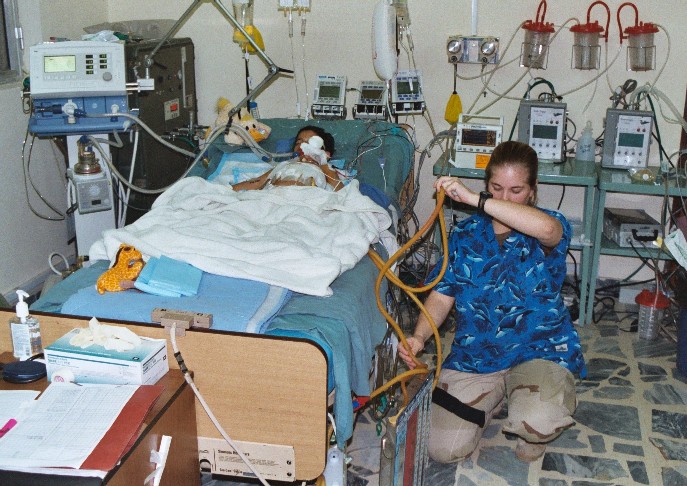Ibn Sina Hospital on:
[Wikipedia]
[Google]
[Amazon]
Ibn Sina Hospital is a hospital in Baghdad,
 During Operation Iraqi Freedom, the hospital was situated in Baghdad's
During Operation Iraqi Freedom, the hospital was situated in Baghdad's
Iraq
Iraq,; ku, عێراق, translit=Êraq officially the Republic of Iraq, '; ku, کۆماری عێراق, translit=Komarî Êraq is a country in Western Asia. It is bordered by Turkey to the north, Iran to the east, the Persian Gulf and K ...
which was opened by four Iraqi doctors – Modafar Al Shather, Kadim Shubar, Kasim Abdul Majeed and Clement Serkis – in 1964. It was purchased for a fraction of its true value by the Iraqi government for use by Saddam Hussein
Saddam Hussein ( ; ar, صدام حسين, Ṣaddām Ḥusayn; 28 April 1937 – 30 December 2006) was an Iraqi politician who served as the fifth president of Iraq from 16 July 1979 until 9 April 2003. A leading member of the revolutio ...
, his family and the Baath Party elite. Uday Hussein
Uday Saddam Hussein ( ar, عدي صدام حسين; 18 June 1964 – 22 July 2003) was an Iraqi politician and the eldest son of Saddam Hussein. He held numerous positions as a sports chairman, military officer and businessman, and was the head ...
was hospitalized there after being wounded in a failed assassination attempt in 1997.
History
The Ibn Sina Hospital in Baghdad was named for the Persian physician Ibn Sina (also known as Avicenna). It was established by four Iraqi physicians in 1964 and became one of the best hospitals in Baghdad. It was seized by Saddam Hussein in 1974 for his own personal and family use. During Operation Iraqi Freedom, the hospital was situated in Baghdad's
During Operation Iraqi Freedom, the hospital was situated in Baghdad's International Zone
An international zone is any area not fully subject to the border control policies of the state in which it is located. There are several types of international zones ranging from special economic zones and sterile zones at ports of entry exe ...
and was run by the United States Armed Forces
The United States Armed Forces are the military forces of the United States. The armed forces consists of six service branches: the Army, Marine Corps, Navy, Air Force, Space Force, and Coast Guard. The president of the United States is ...
from shortly after the downfall of Saddam Hussein
Saddam Hussein ( ; ar, صدام حسين, Ṣaddām Ḥusayn; 28 April 1937 – 30 December 2006) was an Iraqi politician who served as the fifth president of Iraq from 16 July 1979 until 9 April 2003. A leading member of the revolutio ...
in 2003 until 30 September 2009. The hospital was staffed mainly by the US Army and its rotating Combat Support Hospital units as an emergency facility for critically wounded soldiers and civilians, including suspected and confessed insurgents. During the period of US administration of the Ibn Sina, the emergency room saw an average of 300 trauma
Trauma most often refers to:
* Major trauma, in physical medicine, severe physical injury caused by an external source
* Psychological trauma, a type of damage to the psyche that occurs as a result of a severely distressing event
*Traumatic i ...
cases per month.
On 1 October 2009, the hospital was officially handed back to the Government of Iraq as part of the US military drawdown from Baghdad.
The Ibn Sina was made famous through the widely viewed HBO documentary ''Baghdad ER
''Baghdad ER'' is a documentary released by HBO on May 21, 2006. It shows the Iraq War from the perspective of a military hospital in Baghdad. It has some relatively disturbing scenes in it (e.g. amputations), therefore the U.S. Army is official ...
'', which featured the 86th Combat Support Hospital based out of Fort Campbell, Kentucky
Fort Campbell is a United States Army installation located astride the Kentucky–Tennessee border between Hopkinsville, Kentucky and Clarksville, Tennessee (post address is located in Kentucky). Fort Campbell is home to the 101st Airborne Divi ...
, home of the 101st Airborne Division (Air Assault), and was one of several Army hospital units to staff the hospital.
See also
* Avicenne Hospital in ParisReferences
* {{Authority control Hospitals in Iraq United States military hospitals Hospitals established in 1964 1964 establishments in Iraq Avicenna